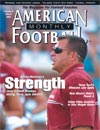AMERICAN FOOTBALL MONTHLY THE #1 RESOURCE FOR FOOTBALL COACHES
Article CategoriesAFM Magazine
|
Power GA versatile running attack is New Mexico State’s strength,but it’s the Power-G that helps open things up.by: Barney Cotton Offensive Coordinator, New Mexico State University © More from this issue First and foremost, our offensive philosophy at New Mexico State is to be a physical football team. We believe in running the ball with a mix of power and option, along with a play-action oriented passing game. Our intent is to make a defense defend the entire field, keeping them off balance, while we control the clock, and, most importantly, score points. An important component of our power package is the Power-G. We feel this is a play for all downs, equally effective as a hammer play in short-yardage or goal line situations as it is versus nickel defenses. The basic rules for the Power-G are as follows: 1. Double or combo the first defender inside the TE. The combo is responsible for the first defender, the....The full article can only be seen by subscribers. Subscribe today!
|
|
|||||||
| HOME |
MAGAZINE |
SUBSCRIBE | ONLINE COLUMNISTS | COACHING VIDEOS |
Copyright 2025, AmericanFootballMonthly.com
All Rights Reserved





